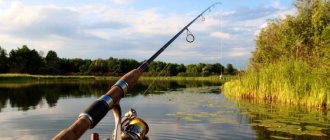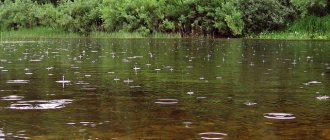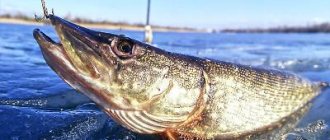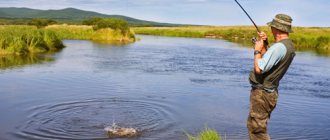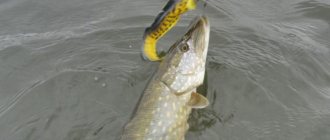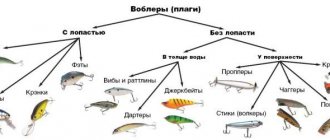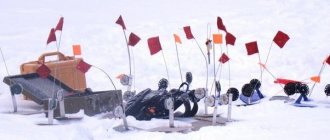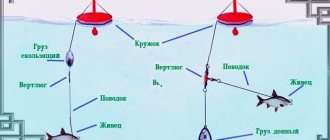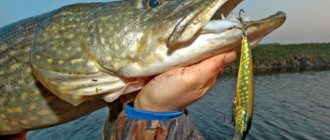Where to catch pike in May
In the spring, having spawned, the pike does not leave the spawning grounds for some time, hunting and restoring strength near them.
So on the river the most promising places are:
- Shallow oxbows and backwaters connected to the main channel by a never-drying ditch or canal.
- The bays are overgrown with last year's and fresh aquatic vegetation.
- Small rivers with a slow flow, shallow depth and an abundance of last year's grass.
- Floodplain lakes connecting to the river.
- Sandy beaches in backwaters, bordered by sharp drops into holes.
On the lake, during a warm and friendly spring, pike are just as very active as on the river. In reservoirs with standing water for pike fishing, you should choose the following places:
- Extensive and shallow watering.
- The mouths of streams and rivers flowing into the lake.
- Flooded trees and bushes lying at shallow depths.
- Flooded stumps and snags.
- The upper edges of the slopes.
When choosing a place in the spring, you should remember that at this time the pike prefers depths of no more than 1.5 meters, since it is there that the water warms up best, thereby attracting small fish on which the predator feeds.
Fishing for pike in May with a spinning rod - where to look?
The only way to catch pike in May using a spinning rod is to look for clean areas of the reservoir where the water is still clear. In such water, on the border with muddy water, there are schools of feeding fish, which select particles of food from the turbidity. Turbidity enters the reservoir with streams and simply with spring streams, which, flowing from the banks, bring into the reservoir everything that is washed out of the soil along the way.
At this moment, the predator also stands on the border of muddy and light water and “grazes” food fish, like a wolf grazes a flock of sheep.
It is typical for any predator, be it perch, pike perch or pike, to choose water with the least amount of suspended dirt. Dirt and turbidity prevent any fish from breathing normally, clog the gills, and reduce activity.
Areas on the border between clear and muddy water work well in May.
Where can you find areas of clear water bordering areas of muddy water in May?
- Firstly, these are areas without a current on the border with relatively clean flows along the banks of a reservoir, where the water is not muddied by wind currents and the channel current does not carry dirt.
- Secondly, these are places where water flows from relatively small, settled bodies of water, such as swamps and forest streams. Forest reservoirs at the time of flood do not carry as much dirt as plain or mountain rivers.
- Thirdly, these are all kinds of isolated backwaters, bays and creeks in which the water, on the one hand, has warmed up, but, on the other hand, still does not mix with the water of the main reservoir.
Fishing for pike in May using a spinning rod in such places will be the most productive. To fish in such places, it is not necessary to go out on the water in a boat. All these places can be easily penetrated with spinning baits from the shore.
When to fish during the day
At the beginning of the month, when the mornings are often still quite cool, the pike begins to actively feed only closer to 9-10 o’clock, when the water in shallow waters warms up, thereby attracting small fish.
This feature is especially well observed during night frosts in May. This is interesting - The best weather for pike, as well as the normal atmospheric pressure for hunting for toothy ones.
Depending on the weather, but, as a rule, from the third ten days of May, pike begins to become more active early in the morning and before sunset. This is interesting: When to catch pike in the spring
Pike feeding begins in May
In the first two or three days, from the moment when a pike can, in principle, be caught, it is only a shadow of its real self. It seems that she is already beginning to understand that it is time to eat, but she is still not strong enough, and her appetite is not yet beastly. You need to know this if you happen to be in these very first days. Pike should not be offered “fast” baits, otherwise there is a high risk of not catching anything at all, when in principle it is very possible to catch.
If we are fishing on the “toadfish”, where there is no current, then at shallow depths the most correct thing is to opt for a small minnow-suspender and guide it with such light, unobtrusive twitching with pauses. These pauses should not be overly long, one and a half to two seconds is enough. But the main thing is that they should exist.
If our “toad pond” is a riverbed pond with depths of more than two meters reached from the shore, then pike can be caught from the depths with a jig with a greater guarantee. The best choice here is a foam rubber with a weight that barely sinks it in its water-soaked state. For a medium-sized foam rubber it is 5–6 grams. I had all sorts of ideas about replacing the jig with some kind of lead equipment - after all, logically, the emphasized smoothness and slowness of the movements of the bait thereby achieved should be beneficial. But the experiment, alas, did not confirm this. So it’s still foam rubber.
In rivers, weakened post-spawning pike tries to avoid any significant current. It stays either on the backwaters in coastal creeks, or on wide reaches with weak “draft”, or, again, at depth - in barrels. We also fish the depths here with jigs. But in other places - both minnow wobblers and Storm’s “tail”. WildEye Suspend is generally a very effective bait in low water, and even more so for sluggish pike. It combines the best qualities of a jig (slow, but still sinks) and a jerky wobbler (twitches and prowls around on twitch).
The pike of the “first days” is sluggish not only when biting, but also when playing. It drags like a piece of polyethylene. But this doesn’t last long...
Spinning for pike in May
To catch May pike, you should correctly assemble the spinning tackle, taking into account the characteristics of fishing, the size and type of bait used. The most suitable gear would be one with the following components (This is interesting: How to choose the right spinning rod).
Rod - for fishing, a 2.4 meter long spinning rod with a fast or ultra-fast action and a cast from 5 to 15-20 grams is used. When fishing with jig baits, the tip of the rod should be thin and sensitive; for wobblers and spinners, blanks with a hard and durable tip are used.
Reel - in pike fishing, the most widely used are inertia-free reels of size 2000-2500, with a front-mounted friction brake, having at least 4 bearings - in this case, the line roller must be equipped with a reliable ball bearing.
The body and rotor of the reel must be made of light and durable carbon fiber alloy. For ease of use of the reel when retrieving and fishing, it is better to choose models that have a comfortable and large knob - that part of the handle with which the angler rotates it. The gear ratio of the reel should be at least 5:1.
We choose and fish with the best spinning rod for:
- jig;
- twitching;
- ultralight.
Line or cord?!
- Cord - for catching pike in the spring, thin and strong braided cords with a cross-section of 0.06 to 0.1 mm are used. When choosing a cord by color, many anglers prefer brightly colored models - this allows them to track the direction of movement of the bait along the line of a brightly colored cord that stands out well on the surface of the water.
- When choosing a cord, preference should be given to original products - cheaper Chinese analogues quickly wear out, fade and lose their strength after one season.
- The leash is thin and flexible, no more than 20 cm long, with a clasp and swivel. These requirements are met by tungsten or thin steel leashes sold in fishing stores, as well as fairly strong and flexible leashes made from guitar string.
You need to tie fishing line/braid to the spool correctly - read here.
Pike with live bait in May
If you can’t fish with a spinning rod because of a ban, we use a float rod with one hook for live bait in local waters. Before the spring ban, you can chase mugs from a boat, and after that you can fish with a float from the shore. On large bodies of water, if the fishing area is not very overgrown, use donkeys. The principles of searching and tactics are similar to spinning - but searching is harder.
With a spinning rod, the angler moves quickly and looks for a predator. When fishing with live bait, you need to choose the right place from the beginning. But, on the other hand, it takes better on live fish if the bite is bad. During this period, it is better to use narrow-bodied, medium-sized live bait. It could be roach, dace, large bleak. A fish that is too small will be attacked by a perch.
Subscribe to the channel:
YouTube channel RYBAFAN
We are VKontakte
Technique for catching May pike
In order to catch a pike in May, it is necessary to take into account the degree of activity of the predator when performing all technical elements.
- The cast - vertical or lateral - must be as accurate as possible.
- Wiring - in May they use more aggressive wiring than in April. Twitching wiring should be without pauses with sharp frequent jerks; I animate jig baits using a standard step-by-step wiring with an average or reeling speed. For spinners, uniform wiring is used.
- Hooking - a sharp and biting wrist hooking with any suspicious blow should pierce the dense and durable tissues of the pike mouth with hooks
- Fishing - with proper hooking, medium and small pike are caught quickly, preventing it from getting tangled in the cord in the grass or snags. Large specimens are fished out carefully, alternately loading the rod blank and the reel - slow pulls are made with the blank, and the slack that forms in this case is removed with the reel.
Peculiarities of pike biting in May
Successful pike fishing in May can be expected when it has already spawned and has recovered from illness after spawning.
Also, the level and transparency of the water greatly influences the fish bite.
Pike spawn soon after the reservoir is cleared of ice at a water temperature of 5-12° C. The duration of pike spawning is 2-3 weeks. After spawning for 1-2 weeks, the pike “gets sick” - does not feed and, accordingly, does not bite at anything. As soon as the fish gets over the disease, the pike begins to eat, which lasts 1-2 weeks. If spawning began at the end of March - beginning of April, then the zhor occurs in the first half of May. During the feeding period, the fish actively feeds and can be caught well with almost any bait.
It should be noted that pike spawn in small and medium-sized rivers earlier, then in large rivers, and last of all, pike spawn in ponds and lakes. What happens? When the pike feeding has already ended on small rivers, there is a chance to get actively biting pike in large rivers. When fish in ponds and lakes are still sick after spawning, fishing on small and medium-sized rivers can be very successful.
Gear selection
There are no special requirements for gear when fishing for May pike.
You should select a spinning rod based on the conditions on the pond and the baits used.
For fishing from a boat or fishing in small bodies of water, a rod with a length of 2.1 - 2.4 m is suitable, for fishing from the shore on medium or large rivers and lakes - 2.7 m.
Tips for catching pike in May
Everyone knows that pike go hunting in May after fasting. Therefore, she is ready to hunt for small fish for a long time. An experienced angler should take this into account when catching.
Most of them advise the following:
- hunt pike in the daytime;
- cast a fishing rod in a shady part of the river, because pike does not like the sun's rays, preferring cloudy weather;
- find a spawning place, because A large number of fish gather for caviar.
Best lures
Considering the condition of the pike, the best bait for it is live bait. The effectiveness of this method will depend on its correct selection and use. Pike responds well to voluminous bait of natural color.
In May, the predator is already distinguished by its activity. You shouldn’t try to attract him again with the bright colors of the victim. To catch bait, it is better to use bread or dough; a moth or maggot is also a good choice. You need to catch the right amount of money. Don't forget about its freshness either.
Experienced fishermen advise periodically changing the water and protecting the caught fish from sunlight.
There are different opinions on whether it is worth feeding a predator or not. Experienced fishermen claim that with the help of complementary foods you can develop a certain reflex, due to which the pike will begin to appear at the right time.
Selection of equipment
The active behavior of pike can play into the hands of fishing enthusiasts, but it is also worth considering the difficulties that may arise as a result of such behavior. A hungry fish that is not the largest size can sometimes create a lot of trouble. By being overly active, it can tangle the line so that knots form on it.
The movement of fish cannot be predicted. The pike may rush into the water or throw a fishing line in the direction of the fisherman. Due to strong resistance, the hook may break or fly out of the predator's mouth.
Especially a lot of strength and patience will be required for bait weighing over 5 kilograms. Therefore, when choosing gear, you need to consider the following:
- the length of the spinning rod must be at least 2.2 meters;
- the case must be durable because it must cope with strong resistance;
- the fishing line should have a diameter of 0.25 to 0.35 mm;
- the composite leash should be 10-15 centimeters long;
- It is better to use steel material, because... Because of the sharp teeth, the fish can bite through the fishing line;
- the hook can be single or double, its width should be 2-2.5 centimeters;
- the optimal weight of the olive sinker is 10-20 grams;
- When choosing a float, we proceed from the weight.
Before installing a leash with a hook, it is worth doing a couple of test requests. Thanks to this, all the shortcomings in the equipment configuration will be visible.
You can also fish using a float rod. This method is chosen by those who like to fish on the shore in complete silence. This is not the most effective way of fishing, but, nevertheless, some remain faithful to it.
You should choose a place with a weak current, for example: a river or pond.
Catching pike with a float rod
Catching pike with a float rod is not the most effective way, but it is no less interesting and is best suited for those who are not going to bother with a spinning rod and for those who do not have a boat. I’ll tell you how to successfully fish with a bamboo rod, 3.5 meters long, with a float made of large cork, the float must be able to withstand a gudgeon, or any other small fish that acts as live bait, the float should be loaded in such a way that the live bait can hardly drag the tackle , but could move halfway through the water, luring the predator with its movements.
Use a double “goat” hook, you can also use other hooks, but if the hook is not large and strong enough, then the broken pike will be on your conscience. Now the process of catching pike with a float rod, choosing a place and time, on which the success of the fisherman sometimes depends to a greater extent than on everything else.
Andrey Shalygin
Why small rivers?
You can make it difficult for yourself and catch pike in May on ponds with marshy banks, on large rivers, lakes, reservoirs, peat bogs - everywhere the toothy one begins to fatten, but the ban on fishing from a boat greatly complicates the life of the spinning angler. Often it’s simply not possible to reach the fish, or it’s impossible to properly iron the points - grass, muddy banks, bushes, densely seated grasshoppers, floaters get in the way - there’s plenty of interference. But why bother with all sorts of problems? Summer will come, and then you can rush to serious reservoirs, but for now, go to small rivers - May is the best time to fish on them!
I also have a large river close by and good lakes nearby, which I often go to in summer and autumn, but in April-May I go mainly to small rivers. The catches usually include one-kilogram pike, two-sized pikes fly in, and there is an intrigue of bites from even larger individuals. And what else does a spinning soul, exhausted by long winter “vacations”, need!? Moreover, the most active bite begins around the May holidays. The zhor lasts until a decent rise in algae, after which I run to a large river, although there are great fans who spin on small rivers until frost, and start at the end of March, and in warm winters even earlier.
Selection of the best spinning baits for pike
The following are perfect for catching pike in May using a spinning rod:
- jig baits,
- wobblers,
- spinners.
So, let's look at each type of bait in more detail.
Jig lures
To catch pike in the river in the spring, you can limit yourself to just jig baits. In standing reservoirs, jig works well primarily on the terrain - on edges, spits, holes, at a depth of one and a half meters.
As for the type of bait, it can be either twisters and vibrotails , or foam fish (it works a little better for pike than silicone, but is less often used by fishermen).
Wobblers
At shallow depths, where wobblers twitched lightly will produce the best results in most situations. In shallow water you have to fish either in small rivers or on any rivers in the second half of May, when a large number of pike have already left the channel holes closer to the shore.
Wobblers are also indispensable when fishing in small ponds and lakes, where they make it possible to fish a large area of water (unlike silicone fish, which cannot be cast far on a light jig head).
Minnow wobblers , such as:
- Flash Minnow TR 95SP from Lucky Craft,
- Rapala X-Rap,
- Evergreen Side Step.
Spoons
Rotating spoons, which create strong vibration when retrieving, the pike reacts well. In the spring, you can take medium-sized spoons, such as:
- Mepps Long No. 1 – 3,
- Mepps Aglia,
- Mepps Black Fury #2 - 5.
The oscillating spoon is a universal bait that can be used both in deep and shallow water. It allows you quickly find fish in any water area. For fishing in May, regular pike spoons of medium and slightly above average size are suitable.
